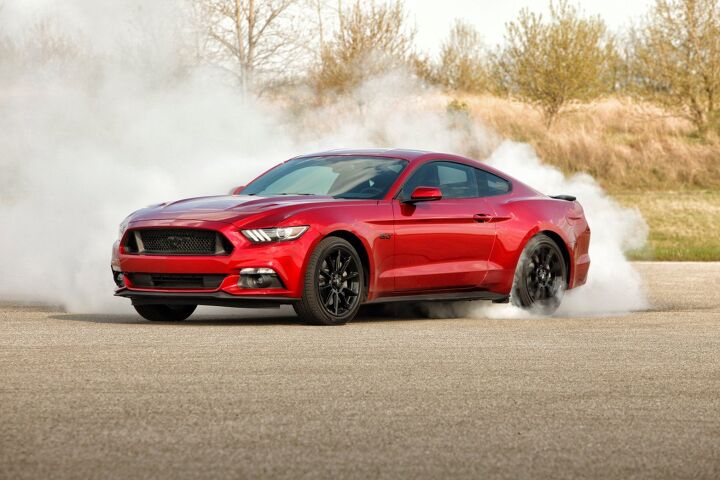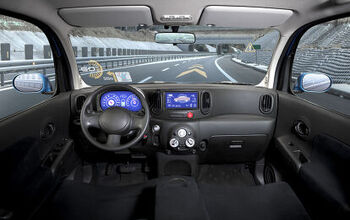Why the Mustang Sells So Well in Europe, and What US Automakers Don't Get
The Ford Mustang is currently the best-selling sports car in Germany and in many other European countries. Sales are so strong that allotments for official importers are usually sold out for the rest of the year and customers are flocking to gray importers, who offer cars at higher prices and without factory warranty.
What made Europeans go crazy for a pony car all of a sudden? Is something changing in European tastes, or is the new Mustang just that good? And why can’t other American cars make it in Europe?
Last month, Germany saw 780 Mustangs registrations. That’s enough to beat everything in the Sportwagen category, including bestsellers like the Audi TT, Mercedes-Benz SLC or any of the sporty Porsches. In my home country, Czech Republic, 44 were registered, beating luxury coupes like the Audi A5 and BMW 4-series, which are not considered “sportscars” in Germany.
That’s an astonishing achievement for an American car in Europe. Since the success of Chrysler’s minivans, no American car (European Fords are just that — European) managed to make itself truly relevant in any market segment. So, let’s look at the factors that made such a thing possible.
The most obvious reason why the Mustang is so hugely popular in Germany is, of course, the pricing. However outrageous it may seem to American eyes, the $48,700 base price for the Mustang GT is a true bargain, as is $43,000 for the four-cylinder Ecoboost model.
To understand why, one must realize that advertised prices in Europe are final. This includes the Value Added Tax, which usually amounts to 20-22 percent, and of course, no further destination charges are allowed. Subtracting the tax (which is, in fact, deductible for VAT-payers who pay the tax on their final product and can deduct it from any business expenses) moves that car much closer to its American pricing. The rest of the difference comes to the fact that in Europe, the base Mustang comes in Premium trim with the Performance Package.
This pits the Mustang against similar competitors it faces in the US. The Ecoboost goes head-to-head with the new crop of “super hatches” like Golf R or Civic Type R, and the GT is competing against much slower cars (like the BMW 440i) or much more expensive ones, like the BMW M4. Maybe even more important, it’s still within the price range of a typical large sedan. A Volkswagen Passat or Ford Mondeo, or even a Škoda Superb, can easily surpass an Ecoboost in price, and their most expensive versions can be pricier than the GT Convertible.
But the fact that the Mustang is cheap would not be enough for it to rake in such massive sales. It has been cheap for quite some time, and gray market cars are readily available in most EU countries. For some buyers, though, the fact that the Mustang is now sold through official Ford dealerships is of a great importance. Some don’t want to deal with a small company that’s not able to offer the warranty and service of an official dealer, others just don’t trust anything “unofficial”.
The fact that the Mustang is officially available for the first time in almost 50 years (and in many countries, like ours, for the first time ever) could be the reason why people who always wanted a Mustang now flock to get one.
Supporting this theory is the fact that at this moment, the Mustang’s European sales consist mostly of V8 cars, while the supposedly Euro-friendly four-cylinder model represents a small minority in most markets. It seems that the really important part of “Euro-friendliness” is not about offering a small engine, but the fact that the Mustang now has a proper, well-tuned suspension and an interior that can stand on its own when displayed next to large European Fords in the showroom. No Mustang since 1973 was able to do that, which is one of the main reasons why the last four generations weren’t available in Europe.
If there are any other reasons for Mustang’s long absence on our market, it’s certainly not the lack of European drivers’ interest in affordable, fast coupes with a big engine. When the Mustang vacated the European market after getting too fat and thirsty for continental tastes and wallets, Europeans just made their own Mustang.
It was called the Ford Capri, and other than being smaller, in line with other European cars of the time, and replacing the Mustang’s I6 and V8 engines with (slightly) less thirsty I4s and V6s, it was just like the Mustang, only with a more primitive suspension. Really — the Capri, which sold almost 2 million copies (at one time, one in four Fords sold in Europe were Capris) had a live rear axle on leaf springs until production ended in 1987.
When the Capri went out of production, followed a year later by its biggest rival, the Opel Manta, dark ages came for brawny rear-wheel drive coupes in Europe. With the lack of mainstream RWD platforms to build on (the Capri was based on the old Escort, the Manta on first generation Ascona), the manufacturers tried to make it work with FWD ones. Ford imported the futuristic but kind of bland Probe, followed by the totally boring “Europeized” Cougar. Opel did better with the Vectra-based Calibra, and Fiat ruled the segment for some time with its striking, muscular, Bangle-designed Coupe, powered by a glorious 2.0-liter five-cylinder turbo.
With mainstream coupes partly dying out and/or moving to uninspiring FWD platforms, the market for fast, stylish coupes fell into the hands of German premium brands — the 3-series coupe and Mercedes CLK still offered some style and, for the Bimmer at least, a sporty character.
Of course, pony cars were still present — but mostly through gray imports. Only occasionally were they available from official dealers, like the Camaro and Firebird in Germany during late 1990s. While the demand was undoubtedly there, the terrible quality of their interiors and ancient live rear axle suspensions kept most European customers away. Even so, the pony cars were always among the most successful cars in the gray market. Mustangs of the previous retro-styled generation sold better than some officially available cars.
There should be no surprise that when the Mustang came to European shores with an official warranty, availability from regular Ford showrooms and a modern suspension (which makes it drive more like a cheaper Jaguar than a thuggish American brute), not to mention an interior that is at least on-par with the Mondeo, the customers went nuts.
For now, it’s probably mostly fanboys who are now ordering the V8 pony cars of their dreams, but I expect the share of Ecoboost cars to rise in the coming years, as people who didn’t specifically lust after a Mustang (but wanted a downmarket/faster alternative to a BMW 4-series) come into the picture. There’s also those who just want a cool-looking coupe to replace their Mondeo wagon after their kids finally leave the nest.
In a way, the Ecoboost Mustang is a replacement for the Capri. When the European pony car was on the market, European Fords were orders of magnitude smaller than U.S. models — the large, luxurious Granada was about the size of a Maverick, and the Cortina (the typical family car of the time) was hardly any bigger than a Pinto. That necessitated a smaller pony car for Europe. Now, Europe’s large Ford is identical to America’s midsize Fusion, and the Mustang suddenly stopped looking out-of-place with its size.
What it is that most American automakers don’t get and what they can learn from this example? European customers are not interested only in small, sophisticated four-cylinder cars. They want big, cool American cars they know from the movies. They just don’t want them to look completely terrible on the inside, and they won’t live with the rear axle on a sports car.
The American cars that sell the best in Europe are those that look most American. The biggest hit for Chrysler? The 300C (and gray import Challengers aren’t doing so bad, either). The most popular Cadillac? Of course, the Escalade. But a Lancia-badged Chrysler 300C? Nah, they won’t fall for that. A four-cylinder Cadillac ATS or even CTS? Dude, where’s my V6?
The Mustang is like a hamburger. It’s quintessentially American, and while you won’t see us Europeans ditching our pasta or Wienerschnitzel for it, we still like to indulge from time to time. A part of us will always like a nice pony car, as much as we like those burgers.
[Image: 2015 Ford Mustang, © 2015 Alex L. Dykes/The Truth About Cars]
More by Vojta Dobe
Latest Car Reviews
Read moreLatest Product Reviews
Read moreRecent Comments
- MaintenanceCosts 308/311 is just the rating of the gas engine by itself. The full powertrain power rating, taking into account both power sources is 483/479. The car will do 0-60 in under five seconds. Frankly, I find the idea of that being "underpowered" bizarre.Also, "understated" has never been less fashionable within my lifetime. We are in a moment where everyone wants to make a Bold Statement with everything they do.
- 28-Cars-Later @PoskySo here's some interesting data, Manheim's Used Car index is still 28% higher than shortly before the Plandemic (155 on chart) after declining from a height of 39% (roughly 215) in January 2022, yet interest rates are now more than double on average. Maybe the White House should focus on some deflationomics instead of mucking up everything?
- Dale Had one. The only car I ever bought because of a review in a guitar magazine.Sure was roomy inside for such a small car. Super practical. Not much fun to drive even with a manual.Sent it to college with my stepson where it got sideswiped. Later he traded it in on an F-150.
- Bd2 Hyundai's designs are indeed among the most innovative and their battery technologies should allow class leading fuel consumption. Smartstream hybrids are extremely reliable.
- 28-Cars-Later So now H/K motors will last longer in between scheduled replacements. Wow, actual progress.




































Comments
Join the conversation
Very good article. Great to see an American brand doing well in Europe.
How is a Mustang GT "massively faster" than a BMW 2 or 4 series? The Ecoboost Mustang has the same 0-60 as the 228i and 428i, the GT is the same as the M235i and 435i - and I suspect it would take a lot of talent to match what an AWD BMW can do by just planting your foot on the floor (but what is the fun of that?). The 440i (assume that is out in Europe) is no slower than the 435i, it just has the newer engine with slightly more power. The BMWs will sit on the 155mph limiter from one side of Germany to the other, repeatedly. Can a Mustang do that these days? Near as I can tell, the Ecoboost is limited to 145, the GT to 155. The V6 a lousy 120 but they don't sell that in Europe. I would hope so, but I don't know - fastest I have driven a Mustang is about 80. American cars used to be notorious for blowing up at sustained high speeds. 0-60 is largely irrelevant in Germany, though 30-155 was a lot of fun leaving Autobahn rest areas. :-) The V8 would likely be a lot of fun doing that too, all that hp is more useful at higher speeds.